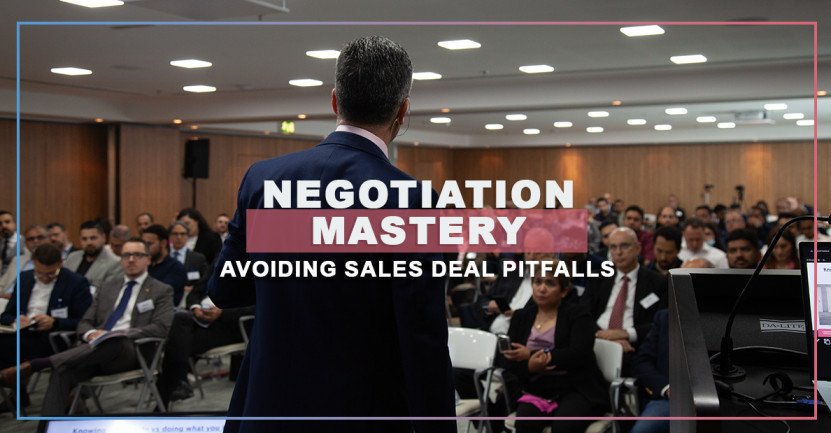A few weeks ago, our team walked into a big client meeting. It was the final round of discussions. We had won the client over and were now negotiating our deal.
The client was a large, reputable organization and the benefits of working on the project were manifold – the money was great, it was an annual contract, the work involved delivering what we do best (which is sales capability development, if you’re wondering), and we would have a big name to add to our client list. It was bound to open a lot more doors for us.
During the meeting, the client chopped down our proposal, demanded new deliverables outside of the pre-discussed scope, squeezed us on payment terms. They did everything they could do to get the best of the deal.
Sound familiar? ‘Business as usual,’ you might say.
At the end of the meeting, the client was ready to sign (at their squeezed terms, of course), it was still good money for our business, but we walked out deciding not to sign the deal.
Why?
Because we realized that this account, as alluring as it may seem, was the wrong decision for us at this point.
This was a demanding client who would drain all of our resources, limit the time and attention we give to our other clients and will be squeezing us every given opportunity.
Though the project in itself might be a good sale for us, it would damage us in the long run and jeopardize some of our long-standing relationships. We had to say ‘no’.
Was it difficult? Absolutely.
When the advantages of a big project or client are staring you in the face, it’s difficult to walk away from the deal. When you’re so close to closing an account that seems like it could be extremely fruitful for business, it’s hard to turn down the offer.
But sometimes, saying no is the best alternative. A ‘bad’ sales deal is never worth pursuing, no matter how much behind your sales targets you are.
Identifying a ‘Bad’ Sales Deal
First, let’s talk about what counts as a ‘bad’ sales deal.
A bad sales deal is one that does more harm than good for your business in the long run. It might seem promising, but once you’ve locked and signed the deal, companies find themselves giving more time and resources than they can afford to, to meet irrationally high customer demands.
Often, for business owners and teams, this also means deviating from their vision and objectives in the draining effort to serve this demanding account.
A bad deal can:
- Waste time that could be better spent on more promising avenues
- Damage relationships with other clients, and with the client involved in the deal
- Hurt your business financially
- Demotivate employees
It takes experience and hard-earned wisdom to turn down a potentially bad sale.
Tips to Prevent Getting Stuck in a Bad Sales Deal

Here are a few tips to prevent yourself from getting stuck in one:
1. In terms of price:
Set a starting point, a midpoint, and walk-away point well before you enter the negotiation phase. Decide at what point and how far you are willing to go before the actual negotiations begin. And then, hold your ground. Write down what each of these figures looks like for you, so you don’t get intimidated by the discussions. Your conviction will help you stand on firm ground even when you’re fighting an uphill battle against someone who is negotiating aggressively.
2. In terms of deliverables:
Be clear on what you can deliver, what you can offer on top of that, and what you cannot deliver at all. Things will start to go downhill pretty quickly if you’ve committed to deliverables during the negotiation phase that you are not able to meet. Have a clear idea of what you can and cannot deliver, and stay in line with that list throughout the discussion. Here too, clearly communicate when you are not going to be able to deliver on a particular client demand. There’s no point in saying yes just to win the account, and then struggle to meet the requirement after.
3. Create your ‘tradables’ list:
Plan ahead and decide on what you are willing to exchange or trade during negotiations. What can you give and what can you ask for in return? It’s no secret that one of the most critical aspects of salesmanship is the art of negotiation. It’s a give-and-take dance. Very rarely does everything go your way. So before you go into the negotiation, create a list of what you are willing to compromise and give to your client, and at the same time what you can ask for in return. Imagine as many possible outcomes as you can. The more creative you get here about what you can offer during negotiations, the more options and scenarios you have and the more room you have to negotiate. Being fully prepared will instill you with confidence once the negotiations begin. . For further insights into negotiation strategies, explore our blog on ‘How to Accelerate Buying Decisions and Sell Faster.’
4. While negotiating, keep emotion out of it:
It’s easy to get frustrated and even angry when you’re negotiating. You might get defensive about what you’re offering and feel like the person on the other side of the table is failing to see the ‘value’ of your product or service. It’s important to keep that in mind and approach the conversation with a calm mind, and with complete clarity on what you’re offering, for how much and how far you are willing to compromise.
5. Never lose sight of the bigger picture:
Remember to always tune into your business’ bigger picture – your mission, your vision, and the change that you want to bring about as an organization. There is a reason you choose to work with certain types of clients and on certain kinds of projects. Find that reason and tune back into it. Every deal that you sign should help you grow as a business, not derail your purpose or vision, no matter how big or small.
6. Remember Your Values:
No deal, good or bad, is worth compromising on your (or your business’) core beliefs and value system. Remembering these makes it easier to walk away from a bad sales deal. Remember why you enjoy your job, and why you enjoy closing a good deal. Sometimes a sales deal might not fit those core criteria for your business, and even if you only come to that realization in the negotiation stage, it might be worth letting go of the deal.
Closing Thoughts
If, after all the efforts you put into the negotiation, your potential customer remains rigid, then that is a red flag that you shouldn’t ignore. If your customer doesn’t participate in the give-and-take of the negotiation, is focused on really squeezing you to get the best out of the deal, and has a ‘my way or the highway’ attitude, then the chances are that even if you sign this one deal, you will never forge a fruitful, long-term business relationship here. At any point during your negotiations, if you feel like a sales deal is pulling you away from your vision or even conflicting with your business’ values, then weigh the situation and decide if it’s worth going ahead with the sale. Watch out for these signs, and learn to say ‘no’ when you see things aren’t looking right.
Remember, closing one wrong door might open many other right doors for you and your business.
One last piece of advice:
You don’t want to burn bridges. You may not have managed to make a sale today, but things change. Your customer may have a change of heart sometime in the future, or they might see your value after they experience a different provider.
So even when you’re saying no at the end of an exhausting negotiation talk, always exit an unfavorable deal in the most diplomatic way possible.
Ready to take your sales negotiations to the next level? Don’t hesitate to reach out to us. Book a discovery call with The Academy for Sales Excellence now and unlock the strategies you need for successful sales outcomes.




